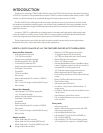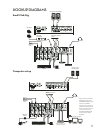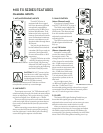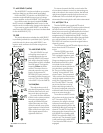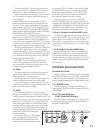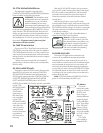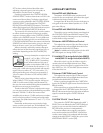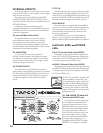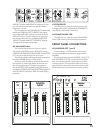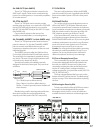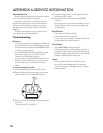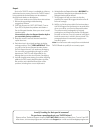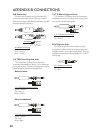
14
INTERNAL EFFECTS
The internal eff ects circuit receives a mono signal
from the AUX 2 FX bus, and it outputs a stereo signal
onto the main mix buses.
The input signal is controlled by the MASTER
AUX SEND 2 knob [28] and the FX INPUT LEVEL
knob [36], while the outputs are controlled by the FX
RETURN [32] knob.
Inside the processor, the analog audio is
converted to digital, this is processed by the internal
DSP eff ects processor, and the result converted into
a stereo analog signal.
34. Internal Eff ects Select Knob
The internal eff ects processor has 16 great
preset eff ects to enhance your sound, confuse
cats, and upset hamsters, if that is your idea of
fun. Each has been carefully modeled to represent
standard eff ects. Note that the eff ects output mutes
momentarily when changing eff ects.
35. VARIATIONS
As you rotate this control from position 1
through 16, the “strength” of the eff ect increases.
For example, if using a reverb eff ect, a low number
produces a short reverb time, and a larger number
produces a longer reverb time.
36. FX INPUT LEVEL
This knob allows you to adjust the signal level
going into the internal eff ects processor. As a general
rule, adjust the FX INPUT LEVEL knob until you just
barely see the FX OL LED [37] blink. This will give
you the best signal-to-noise ratio for the eff ects
signal.
37. FX OL
This LED indicates when you are approaching the
clipping point for the digital eff ects processor. If you
see the FX OL overload light blinking frequently, turn
down the FX INPUT LEVEL knob until it just turns off
during the louder passages, riff s, chords, yells, etc.
38. FX BYPASS
Press this switch in to bypass the internal eff ects
processor, and so prevent its output from appearing
on the main mix or stage monitors. The LED next
to the BYPASS switch reminds you whenever the
processor is bypassed.
Use BYPASS if you are not using the internal
eff ects, or use it to quickly compare between the
eff ective eff ect of eff ects and the eff ect of no eff ects.
MAIN MIX, SUBS, and POWER
LEDs
39. ALT 3-4 Master Faders (Mix.220FX)
These faders control the level of the signals sent
to the ALT 3-4 OUTS [53]. Remember, channels are
routed to the ALT 3-4 OUTS when their MUTE/ALT
3-4 switch is pushed in (Mix.220FX only).
40. SUB 1-2 Master Faders (Mix.260FX)
These faders control the level of the signals sent to
the SUB OUTS [54]. All channels that have their Sub
1-2 assign switch [18] pushed in appear at the SUB
OUTS (Mix.260FX only).
The ALT 3-4 and SUB 1-2 signal is off
when the faders are fully down, the
“U” marking is unity gain, and fully up
provides 10 dB of additional gain. If
you are using the two ALTS or SUBS
as a stereo pair, make sure that both
faders “ride” together to maintain the
left/right balance.
41. SUB ASSIGN TO MAIN MIX
Switches (Mix.260FX only)
One popular use of the subgroups
is to use them as master faders for
a group of channels on their way to
the MAIN MIX. Let’s say you’ve got a
drum kit using several channels and
you’re going to want to adjust the
overall volume of just the drums with
two master faders. Just un-assign
these channels from the MAIN MIX,
reassign them to subgroups 1-2,
engage the SUB ASSIGN TO MAIN
MIX LEFT on subgroup 1 and SUB
VARIATIONS
INTERNAL EFFECTS
FX OL
FX OL
FX
FX
INPUT
INPUT
LEVEL
LEVEL
ROTAR
ROTAR
Y
THEATE
THEATE
R
FLANGE
FLANGE
R
ROOM
ROOM
STAG
STAG
E
SPRIN
SPRIN
G
TREMOL
TREMOL
D
FLANGER+RE
FLANGER+RE
V
HAL
AL
L
CHORU
CHORU
S+RE
S+RE
V
CATHEDRAL
CATHEDRAL
STUDIO
STUDIO
STEREO DE
STEREO DE
LA
LA
Y
ECH
ECH
O
CHORUS
CHORUS
ECHO+RE
ECHO+RE
V
1
2
3
4
5
6
7
8
9
10
10
11
11
12
12
13
13
14
14
15
15
16
16
FX
FX
BYPASS
BYPASS
MAX
MAX
34
35
36
38
37
LOOK
CLOSER



